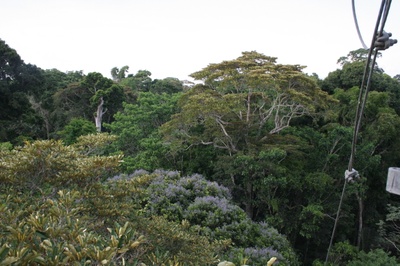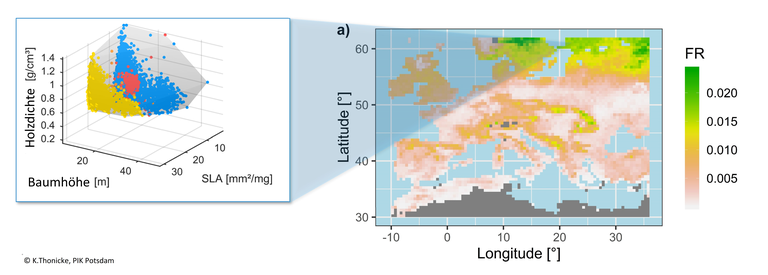We develop modelling approaches to capture functional diversity in our flexible-trait DGVM LPJmL-FIT and apply the model to study functional diversity and ecosystem function in the Amazon rainforests and European natural forests.
Background

In reality, an ecosystem contains manifold plant species, with each of them having a particular niche and function within the ecosystem. The stability of an ecosystem and its potential to adapt to a changing environment depends strongly on this (functional) diversity. Consequently also ecological tipping points, i.e. critical thresholds beyond which an abrupt shift between alternate ecological stable states occurs, are most sensitive to this diversity.
Research goals and questions
Enhancing the degree of diversity implemented in large-scale vegetation modeling allows us (A) exploring the effects of plant functional diversity on the elasticity and stability of biomes under climate and land use change, and (B) conducting a risk assessment for tipping in Amazon rainforests and the feedbacks to the climate system.
- How does functional diversity influence different ecosystem functions?
- When does a combination of degraded ecosystem functions endanger the stability of the ecosystem?
- How do ecosystem tipping points change the climate and influence the Earth system?
- How can we improve risk assessments for potential ecosystem tipping points?
Outcome
Our research aims to contribute to advance our understanding on biodiversity and ecosystem functioning of tipping elements such as the Amazon rainforest. The Amazon rainforests are a highly diverse biome and faces a number of threats, a first insight gives the infographic of the Leibniz Association (in German). A recent review, to which Kirsten Thonicke contributed, summarized the current knowledge on impacts of climate and land-use change on the Amazon biome and was rewritten for Frontiers for young minds. We applied our flexible-trait DGVM LPJmL-FIT to understand how plant trait diversity enables biomass recovery in Amazon rainforests under climate change.
We found that co-existence of functionally diverse trees (within and across plant functional types) emerges from life-history strategies, disturbance and tree demography in European natural forests applying our flexible-trait DGVM LPJmL-FIT. PFTs are now simulated without bioclimatic limits. We contribute to advance the concept of functional diversity using simulated plant traits of the leaf and stem-economic spectra.

Trait combinations of individual trees which compete in forest patches (here in a grid cell in the boreal zone) form a trait space (grey 3-D cube in left panel) from which, e.g. functional richness (FR) can be derived and mapped at the continental scale. We study how climate gradients and climate change impact functional diversity and ecosystem stability in several biomes.




